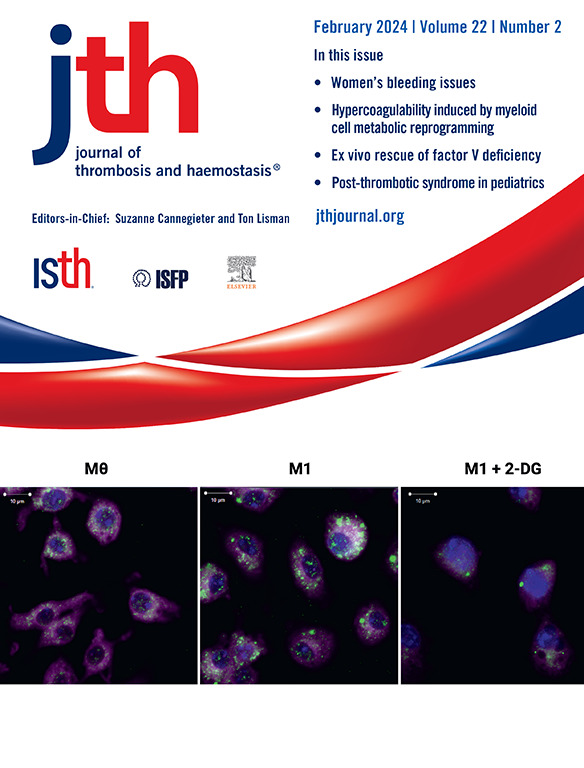抗cith3 IgG:与抗nets抗体及抗磷脂综合征血栓形成高度相关的新抗体。
IF 5
2区 医学
Q1 HEMATOLOGY
引用次数: 0
摘要
背景:中性粒细胞胞外陷阱(NETs)参与血栓形成的发展。发现抗NETs抗体为NETs和血栓形成过程之间的联系提供了新的认识。然而,这些抗体目前只被认为是一个多样化的群体,它们的确切组成仍然未知。目的:鉴定抗cith3 IgG并分析其与抗nets抗体及血栓形成的关系。方法:对38例抗磷脂抗体(aPL)阳性患者进行血浆抗瓜氨酸组蛋白H3(抗cith3) IgG和抗nets IgG检测。我们研究了这些抗体之间的关系以及抗cith3 IgG与血栓事件之间的联系。此外,我们通过各种实验探索了抗cith3 IgG如何影响NETs清除和血小板活化,以了解其促血栓形成机制。结果:研究表明,抗cith3 IgG水平升高的个体血栓发生率增加,并证实了抗cith3 IgG和抗nets IgG之间存在强相关性。体外和体内实验均表明,抗cith3 IgG抑制NETs的清除。将该抗体引入血小板和NETs共培养后,p -选择素和CD40L水平升高,表明血小板活化增强。此外,在小鼠模型中,抗cith3 IgG的存在导致血栓形成率增加,从而证实了其在血栓形成中的作用。结论:抗cith3 IgG与抗nets IgG具有相似的重要意义。Anti-CitH3 IgG通过抑制NETs降解间接增强血小板活化,加重血栓形成,对血栓形成的预测具有重要价值,并有可能成为评估血栓形成风险的新生物标志物。本文章由计算机程序翻译,如有差异,请以英文原文为准。
Anti-citrullinated histone H3 immunoglobulin G: new antibodies highly correlate with anti-neutrophil extracellular traps antibodies and thrombosis in antiphospholipid syndrome
Background
Neutrophil extracellular traps (NETs) are involved in the development of thrombosis. Discovering anti-NETs antibodies has provided new understanding of how NETs and thrombotic processes are connected. However, these antibodies are currently only recognized as a diverse group, with their exact makeup still unknown.
Objectives
To identify anti-citrullinated histone H3 (CitH3) immunoglobulin (Ig) G and analyze its relationship with anti-NETs antibodies and thrombosis.
Methods
We studied 38 antiphospholipid antibody-positive patients to measure anti-CitH3 IgG and anti-NETs IgG in their plasma. We examined the relationship between these antibodies and the link between anti-CitH3 IgG and thrombotic events. Additionally, we explored how anti-CitH3 IgG affects NETs clearance and platelet activation through various experiments to understand their prothrombotic mechanisms.
Results
This study demonstrated an increased incidence of thrombosis in individuals with elevated anti-CitH3 IgG levels and confirmed a robust correlation between anti-CitH3 IgG and anti-NETs IgG. Both in vitro and in vivo experiments revealed that the anti-CitH3 IgG impeded the clearance of NETs. The introduction of this antibody into a coculture of platelets and NETs resulted in elevated levels of P-selectin and CD40L, suggesting enhanced platelet activation. Furthermore, in a murine model, the presence of anti-CitH3 IgG led to increased rates of thrombosis, corroborating its role in thrombosis.
Conclusion
Anti-CitH3 IgG and anti-NETs IgG are similar and important. Anti-CitH3 IgG indirectly enhances platelet activation and exacerbates thrombosis by inhibiting NETs degradation, making it valuable for predicting thrombosis and potentially serving as a new biomarker for assessing thrombosis risk.
求助全文
通过发布文献求助,成功后即可免费获取论文全文。
去求助
来源期刊
CiteScore
24.30
自引率
3.80%
发文量
321
审稿时长
1 months
期刊介绍:
The Journal of Thrombosis and Haemostasis (JTH) serves as the official journal of the International Society on Thrombosis and Haemostasis. It is dedicated to advancing science related to thrombosis, bleeding disorders, and vascular biology through the dissemination and exchange of information and ideas within the global research community.
Types of Publications:
The journal publishes a variety of content, including:
Original research reports
State-of-the-art reviews
Brief reports
Case reports
Invited commentaries on publications in the Journal
Forum articles
Correspondence
Announcements
Scope of Contributions:
Editors invite contributions from both fundamental and clinical domains. These include:
Basic manuscripts on blood coagulation and fibrinolysis
Studies on proteins and reactions related to thrombosis and haemostasis
Research on blood platelets and their interactions with other biological systems, such as the vessel wall, blood cells, and invading organisms
Clinical manuscripts covering various topics including venous thrombosis, arterial disease, hemophilia, bleeding disorders, and platelet diseases
Clinical manuscripts may encompass etiology, diagnostics, prognosis, prevention, and treatment strategies.

 求助内容:
求助内容: 应助结果提醒方式:
应助结果提醒方式:


